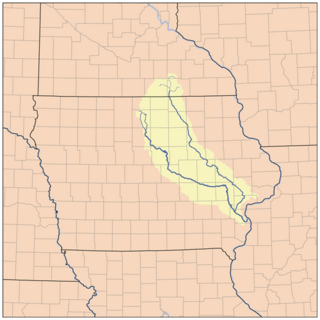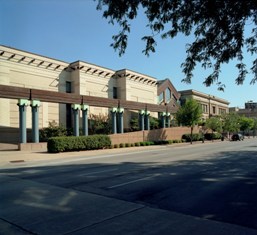Related Research Articles

Ames is a city in Story County, Iowa, United States approximately 30 miles (48 km) north of Des Moines in central Iowa. It is best known as the home of Iowa State University (ISU), with leading Agriculture, Design, Engineering, and Veterinary Medicine colleges. A United States Department of Energy national laboratory, Ames Laboratory, is located on the ISU campus.

Cedar Falls is a city in Black Hawk County, Iowa, United States. As of the 2010 census, the city population was 39,260. It is home to the University of Northern Iowa, a public university.

Waterloo is a city in and the county seat of Black Hawk County, Iowa, United States. and the city is part of the Waterloo – Cedar Falls Metropolitan Statistical Area.

Cedar Rapids is the second-largest city in Iowa and is the county seat of Linn County. The city lies on both banks of the Cedar River, 20 miles (32 km) north of Iowa City and 100 miles (160 km) northeast of Des Moines, the state's capital and largest city. It is a part of the Cedar Rapids/Iowa City Corridor of Linn, Benton, Cedar, Jones, Johnson, and Washington counties.

Grant DeVolson Wood was an American painter best known for his paintings depicting the rural American Midwest, particularly American Gothic (1930), which has become an iconic painting of the 20th century.

The Cedar River is a 338-mile-long (544 km) river in Minnesota and Iowa. It is a tributary of the Iowa River, which flows to the Mississippi River. The Cedar River takes its name from the red cedar trees growing there, and was originally called the Red Cedar River by the Meskwaki. The first Mississippi steamboat reached Cedar Rapids, Iowa in 1844, and during the next decade, the Red Cedar was an important commercial waterway. The surrounding region is known officially as the Cedar River Valley, though it is more commonly referred to simply as the Cedar Valley.

American Gothic is a 1930 painting by Grant Wood in the collection of the Art Institute of Chicago. Wood was inspired to paint what is now known as the American Gothic House in Eldon, Iowa, along with "the kind of people I fancied should live in that house". It depicts a farmer standing beside his daughter – often mistakenly assumed to be his wife.
Washington High School is a public high school in Cedar Rapids, in the U.S. state of Iowa. Built in 1956, it is named in honor of the oldest high school in Cedar Rapids.

The Paramount Theatre in Cedar Rapids, Iowa, is a 6-story brick building located in downtown Cedar Rapids, Iowa. It was individually listed on the National Register of Historic Places in 1976. In 2015 it was included as a contributing property in the Cedar Rapids Central Business District Commercial Historic District.

Coe College is a private liberal arts college in Cedar Rapids, Iowa. Founded in 1851, the institution is historically affiliated with the Presbyterian Church (USA). It is a member of the Associated Colleges of the Midwest and the Association of Presbyterian Colleges and Universities.

The American Gothic House, also known as the Dibble House, is a house in Eldon, Iowa, designed in the Carpenter Gothic style with a distinctive upper window. It was the backdrop of the 1930 painting American Gothic by Grant Wood, generally considered Wood's most famous work and among the most recognized paintings in twentieth century American art. Grant Wood, who observed the house only twice in his lifetime, made only an initial sketch of the house—he completed American Gothic at his studio in Cedar Rapids.

The Iowa flood of 2008 was a hydrological event involving most of the rivers in eastern Iowa beginning around June 8, 2008 and ending about July 1. Flooding continued on the Upper Mississippi River in the southeastern portion of the state for several more days. The phrase "Iowa's Katrina" was often heard.

The Cedar Rapids Museum of Art is a museum in downtown Cedar Rapids, Iowa, United States. The museum is privately owned and was established in 1905. The museum acquired the old Cedar Rapids Public Library building after the library moved into a new location in 1985. The current home of the museum, designed by post-modern architect Charles Moore, was built adjoining the old library in 1989.

The Veteran's Memorial Building is located on May's Island in the middle of the Cedar River in Cedar Rapids, Iowa, United States. It is a contributing property to the May's Island Historic District that was listed on the National Register of Historic Places in 1978. The building served as the Cedar Rapids City Hall until it was damaged in the Flood of 2008. The Building underwent a ribbon-cutting ceremony to mark its official re-opening April 15, 2014.

The Iowa Masonic Library and Museum, located at 813 First Ave. SE, in Cedar Rapids, Iowa, United States, is one of the largest Masonic libraries in the world, and incorporates at least three museum collections. The library was the first, world-wide, to have its own building. Its current building also houses the administrative offices for the Grand Lodge of Iowa, one of the governing bodies for Freemasonry in Iowa.

The Hotel Roosevelt is an historic structure located in downtown Cedar Rapids, Iowa, United States. It was individually listed on the National Register of Historic Places in 1991. In 2015 it was included as a contributing property in the Cedar Rapids Central Business District Commercial Historic District. The building is now known as the Roosevelt Lofts.

The African American Museum of Iowa (AAMI), nestled along the Cedar River near downtown Cedar Rapids, Iowa, United States, has been carrying out its mission “To preserve, publicize, and educate the public on the African American heritage and culture of Iowa” since its incorporation as a 501(c)(3) organization in 1994. It has become the leading educational resource on African American history in Iowa and has two on-site exhibits: a permanent exhibit called Endless Possibilities, and the 2017 temporary exhibit – If Objects Could Talk. Additionally, the AAMI has several "traveling exhibits" that are available free of charge for use by schools, libraries, businesses, etc.

Theatre Cedar Rapids (TCR) is a community theatre in Cedar Rapids, Iowa. The theatre performs several stage shows every year, and offers acting classes. Each year TCR is seen by more than 50,000 patrons, who view the work of over 35,000 volunteer hours.

The George B. Douglas House, which later became known as Turner Mortuary East, is owned today by The History Center, Linn County Historical Society. This historic building located in Cedar Rapids, Iowa, United States. The house was built for Douglas who was a partner in a cereal mill that became the Quaker Oats Company. David Turner bought the property in 1924 and converted the house into a funeral home. He was a patron of regionalist artist Grant Wood, and Turner leased the carriage house to him from 1924 to 1933. Wood used it as his residence, along with his mother, and as a studio. It was here at #5 Turner Alley that he painted two of his most famous paintings, American Gothic (1930) and Stone City (1930). Wood also worked as a decorator when he lived here and designed the interior of the main house when it was converted into a funeral home. His work included two stained glass windows that flank the main entrance. Several Wood paintings also hung in the funeral home.

The Cedar Rapids Central Business District Commercial Historic District is a nationally recognized historic district located in Cedar Rapids, Iowa, United States. It was listed on the National Register of Historic Places in 2015. At the time of its nomination it consisted of 60 resources, which included 46 contributing buildings, one contributing structure, 12 non-contributing buildings, and one non-contributing structure. Cedar Rapids was platted on the east bank of the Cedar River as Rapids City in 1841, and it was incorporated under the same name in 1849. Kingston was established on the west bank of the river in 1852. The two smaller communities consolidated in 1870 as Cedar Rapids. The streets were laid out parallel and perpendicular to the river, which flowed from the northwest to the southeast. The Chicago, Iowa and Nebraska Railroad was the first to arrive in the community in 1859 and the tracks were laid on Fourth Street on the eastern edge of the central business district. The first bridge across the river was built at Third Avenue in 1871.
References
- ↑ Dave Dewitte (June 12, 2010). "Historical Society certifies C.R. cultural district". The Gazette (Cedar Rapids, IA). Retrieved November 4, 2017.
- ↑ Nollen, Diane (July 12, 2010). "A sense of place, pride". McClatchy - Tribune Business News.
- ↑ "State Certifies Grant Wood Cultural District in Downtown Cedar Rapids". Targeted News Service. June 11, 2010.
- ↑ Grant Wood Studio